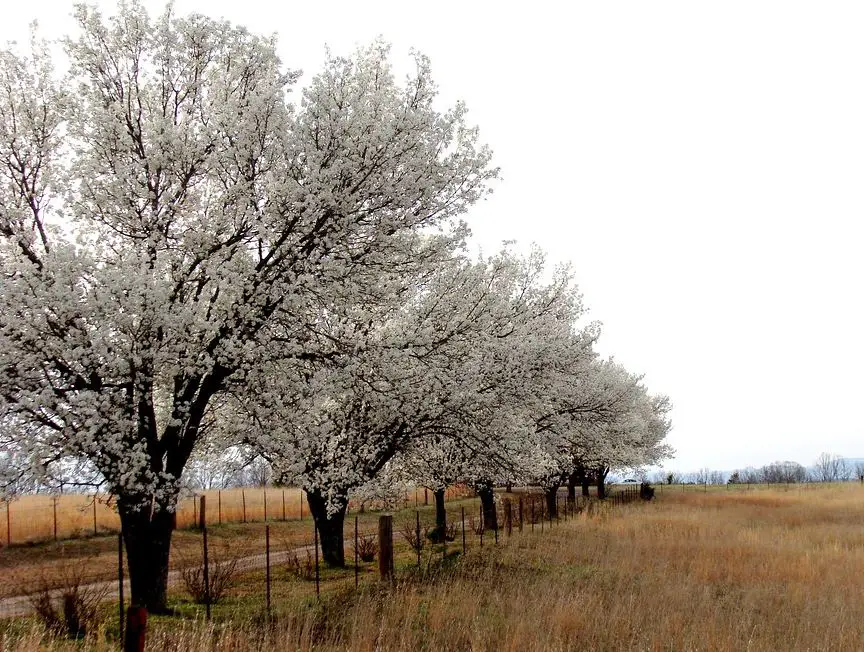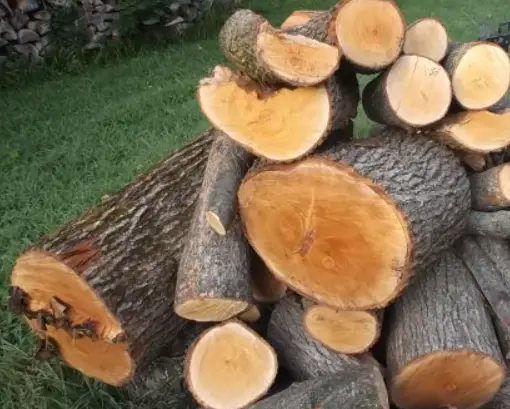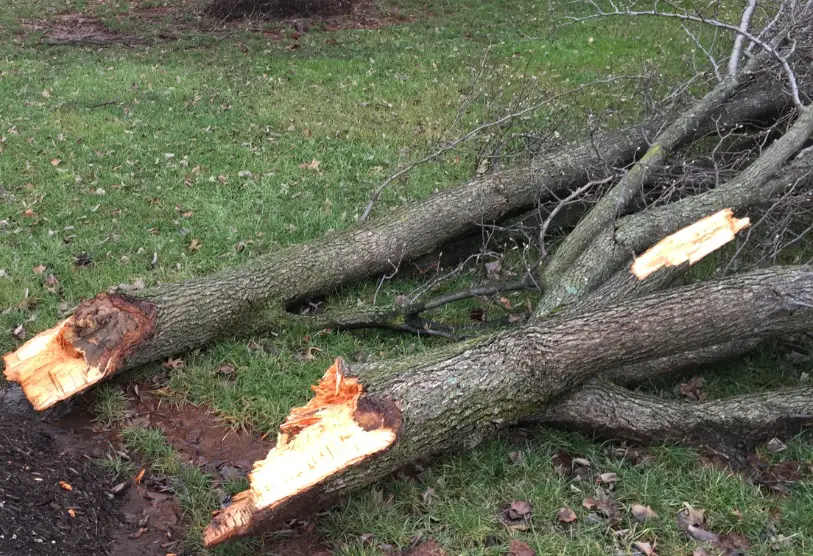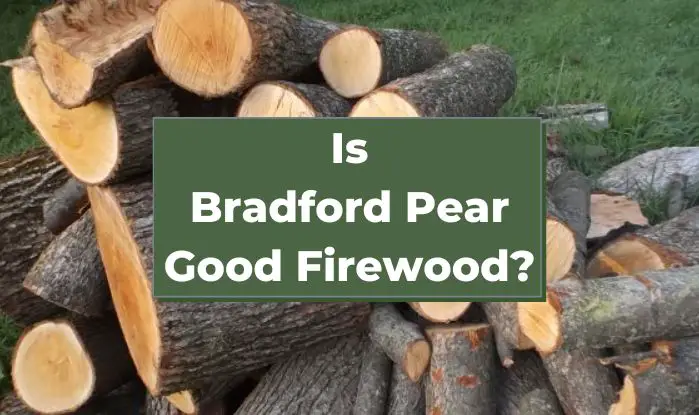Many people wonder if Bradford Pear is a good firewood. With its abundance in many US states, it’s a natural question. After all, when it comes to firewood, you want to make sure you’re using the best option available to you.
Fortunately, the answer is yes – Bradford Pear is a good firewood because it’s dense and burns hot and is also a safe wood to burn, with minimal sparks and smoke.
However, there are some things to keep in mind if you’re planning on using Bradford Pear as firewood. In this article, we’ll take a closer look at the benefits and drawbacks of burning Bradford Pear wood, as well as some tips for using it effectively.
What is Bradford Pear?

The Bradford Pear tree is a deciduous species that originates from China and Korea. It was brought to the United States in the 1960s for its ornamental value, due to its stunning white blossoms in spring and its striking red and orange foliage in autumn. Its rapid growth and low maintenance requirements made it a favored choice for landscaping.
These trees can grow up to 50 feet tall and 30 feet wide, with a pyramidal shape and a dense canopy of leaves that provides ample shade. The bark of the tree is gray and smooth, and the branches are thick and sturdy.
Bradford Pear trees have a weak branch structure that makes them prone to breaking and splitting from storms, and they’re also susceptible to diseases and pests like fire blight and pear psylla.
Despite these drawbacks, Bradford Pear trees have become a popular source of firewood due to their high BTUvalue.
Properties of Bradford Pear as Firewood
Heat Production and BTU Content
Bradford Pear firewood has a very high BTU content of around 26.5 million BTUs per cord, putting it on par with Black Birch, Oak, and Hickory . This makes it one of the best burning firewoods available. Its BTU content is higher than many oak varieties and ash, though it falls slightly short of hickory. This high BTU content means that Bradford Pear produces a hot fire that can last a long time.
Moisture Content
Like all firewood, the moisture content of Bradford Pear is an important factor in how well it burns. When first cut, Bradford Pear firewood has a high moisture content, but it dries quickly and easily. Once it is dry, it burns cleanly and produces very little smoke. This makes it a great choice for those who want to enjoy a fire without the unpleasant smell of smoke that some other firewoods produce.
Density
Bradford Pear is a hardwood, which means that it’s heavy and dense, which makes it a great choice for firewood since hardwoods produce a long-lasting fire that generate lots of heat. When burned, it produces a coal bed which can be used to cook food as well as provide heat. Additionally, because it is so dense, it produces very few sparks, which makes it a safer option than some other types of firewood.
Overall, Bradford Pear is an excellent choice for firewood. Its high BTU content, low moisture content, and density make it a great option for those who want to enjoy a long-lasting, hot fire that burns cleanly and produces very little smoke.
Advantages of Using Bradford Pear as Firewood

Availability
Bradford pear is a popular tree species that can be found in most regions of the United States. This means that it is readily available to those who wish to use it as firewood. Additionally, because it is considered an invasive species in some areas, can be had cheaply or even for free if you’re lucky.
Burns Clean
One of the biggest advantages of using Bradford pear as firewood is that it burns clean. This means that it produces very little smoke and creosote, which can be harmful to your health and can also build up in your chimney and cause a fire hazard. Additionally, the clean burn of Bradford pear means that it produces less ash, making it easier to clean up after your fire.
Overall, Bradford pear is a great option for those who want a reliable and efficient firewood. Its availability, ease of splitting, and clean burn make it a great choice for your next campfire or wood-burning stove.
Low Sparks and Embers
Bradford pear firewood produces a relatively low amount of sparks and embers like Black Locust, Hickory, and Oak, making it more pleasant for use in a campfire and safer to use in a fireplace versus other types of woods that spark more, like Poplar or Hemlock.
Disadvantages of Using Bradford Pear as Firewood

Difficult to Split
Bradford pear is a dense and heavy wood, which makes it a little tough to split in the first place. The unique branch structure of the Bradford Pear also creates many knots in the wood, making it even harder to split, and there aren’t many straight or long sections of the tree that you can cut into logs.
Rots Easily
Bradford pear wood can rot easily, so it is not ideal for areas where firewood is stored outside, which is usually how most wood sheds are set up.
How Long to Season Bradford Pear Firewood
Seasoning firewood is a crucial step in ensuring that it burns efficiently and safely. Bradford pear wood can dry out fairly quickly, needing only 12-18 months to be ready to burn. However, it is important to note that drying times can vary depending on the climate, humidity levels, and how the wood is stored.
Some people report that you can properly season Bradford Pear firewood in as little as 6 to 8 months if you have full sun and wind on it, but just make sure you don’t have it exposed to high moisture levels so it doesn’t start rotting.
To properly season Bradford pear firewood, it should be cut, split, and stacked in a dry, well-ventilated area. The wood should be stacked in a way that allows air to circulate freely around each piece. This will help the wood to dry out evenly and prevent mold and rot from developing.
If you’re in a hurry and need to use the wood sooner, you can split it thin and keep it dry. This will help to speed up the drying process, but keep in mind that the wood may not burn as efficiently as fully seasoned wood.
It’s important to check the moisture content of the wood before burning it. Wood that is too wet will be difficult to light and will produce more smoke and creosote, which can lead to chimney fires.
Overall, while Bradford pear wood can dry out fairly quickly, it’s important to take the time to properly season it to ensure that it burns efficiently and safely. By following the proper steps for seasoning firewood, you can enjoy the benefits of this excellent firewood for years to come.

